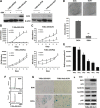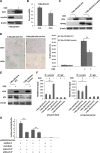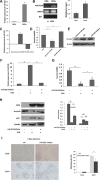Overexpression of KLF4 promotes cell senescence through microRNA-203-survivin-p21 pathway
- PMID: 27531889
- PMCID: PMC5312384
- DOI: 10.18632/oncotarget.11200
Overexpression of KLF4 promotes cell senescence through microRNA-203-survivin-p21 pathway
Abstract
Krüppel-like factor 4 (KLF4) is a transcription factor and functions as a tumor suppressor or tumor promoter in different cancer types. KLF4 regulates many gene expression, thus affects the process of cell proliferation, differentiation, and apoptosis. Recently, KLF4 was reported to induce senescence during the generation of induced pluripotent stem (iPS) cells, but the exact mechanism is still unclear. In this study, we constructed two doxycycline-inducing KLF4 cell models, and demonstrated overexpression of KLF4 could promote cell senescence, detected by senescence-associated β-galactosidase activity assay. Then we confirmed that p21, a key effector of senescence, was directly induced by KLF4. KLF4 could also inhibit survivin, which could indirectly induce p21. By miRNA microarray, we found a series of miRNAs regulated by KLF4 and involved in senescence. We demonstrated that KLF4 could upregulate miR-203, and miR-203 contributed to senescence through miR-203-survivin-p21 pathway. Our results suggest that KLF4 could promote cell senescence through a complex network: miR-203, survivin, and p21, which were all regulated by overexpression of KLF4 and contributed to cell senescence.
Keywords: KLF4; miR-203; p21; senescence; survivin.
Conflict of interest statement
The authors declare no conflicts of interest.
Figures






Similar articles
-
Krüppel-like factor 4 represses transcription of the survivin gene in esophageal cancer cell lines.Biol Chem. 2009 May-Jun;390(5-6):463-9. doi: 10.1515/BC.2009.060. Biol Chem. 2009. PMID: 19361279
-
Deregulated KLF4 Expression in Myeloid Leukemias Alters Cell Proliferation and Differentiation through MicroRNA and Gene Targets.Mol Cell Biol. 2015 Dec 7;36(4):559-73. doi: 10.1128/MCB.00712-15. Print 2016 Feb 15. Mol Cell Biol. 2015. PMID: 26644403 Free PMC article.
-
MicroRNA-7 inhibits the stemness of prostate cancer stem-like cells and tumorigenesis by repressing KLF4/PI3K/Akt/p21 pathway.Oncotarget. 2015 Sep 15;6(27):24017-31. doi: 10.18632/oncotarget.4447. Oncotarget. 2015. PMID: 26172296 Free PMC article.
-
Krüppel-like factor 4 (KLF4): What we currently know.Gene. 2017 May 5;611:27-37. doi: 10.1016/j.gene.2017.02.025. Epub 2017 Feb 22. Gene. 2017. PMID: 28237823 Free PMC article. Review.
-
KLF4, p21 and context-dependent opposing forces in cancer.Nat Rev Cancer. 2006 Jan;6(1):11-23. doi: 10.1038/nrc1780. Nat Rev Cancer. 2006. PMID: 16372018 Review.
Cited by
-
Long non-coding RNA TUG1-mediated down-regulation of KLF4 contributes to metastasis and the epithelial-to-mesenchymal transition of colorectal cancer by miR-153-1.Cancer Manag Res. 2019 Sep 24;11:8699-8710. doi: 10.2147/CMAR.S208508. eCollection 2019. Cancer Manag Res. 2019. PMID: 31576172 Free PMC article.
-
miR-25 enhances cell migration and invasion in non-small-cell lung cancer cells via ERK signaling pathway by inhibiting KLF4.Mol Med Rep. 2018 May;17(5):7005-7016. doi: 10.3892/mmr.2018.8772. Epub 2018 Mar 16. Mol Med Rep. 2018. PMID: 29568911 Free PMC article.
-
A RUNX-targeted gene switch-off approach modulates the BIRC5/PIF1-p21 pathway and reduces glioblastoma growth in mice.Commun Biol. 2022 Sep 9;5(1):939. doi: 10.1038/s42003-022-03917-5. Commun Biol. 2022. PMID: 36085167 Free PMC article.
-
KLF15 Inhibits Cell Proliferation in Gastric Cancer Cells via Up-Regulating CDKN1A/p21 and CDKN1C/p57 Expression.Dig Dis Sci. 2017 Jun;62(6):1518-1526. doi: 10.1007/s10620-017-4558-2. Epub 2017 Apr 18. Dig Dis Sci. 2017. PMID: 28421457
-
Deletion of SA β-Gal+ cells using senolytics improves muscle regeneration in old mice.Aging Cell. 2022 Jan;21(1):e13528. doi: 10.1111/acel.13528. Epub 2021 Dec 13. Aging Cell. 2022. PMID: 34904366 Free PMC article.
References
-
- Rowland BD, Bernards R, Peeper DS. The KLF4 tumour suppressor is a transcriptional repressor of p53 that acts as a context-dependent oncogene. Nature cell biology. 2005;7:1074–1082. - PubMed
-
- Rowland BD, Peeper DS. KLF4, p21 and context-dependent opposing forces in cancer. Nat Rev Cancer. 2006;6:11–23. - PubMed
-
- Yang Y, Goldstein BG, Chao HH, Katz JP. KLF4 and KLF5 regulate proliferation, apoptosis and invasion in esophageal cancer cells. Cancer Biol Ther. 2005;4:1216–1221. - PubMed
-
- Kanai M, Wei D, Li Q, Jia Z, Ajani J, Le X, Yao J, Xie K. Loss of Kruppel-like factor 4 expression contributes to Sp1 overexpression and human gastric cancer development and progression. Clin Cancer Res. 2006;12:6395–6402. - PubMed
MeSH terms
Substances
LinkOut - more resources
Full Text Sources
Other Literature Sources

